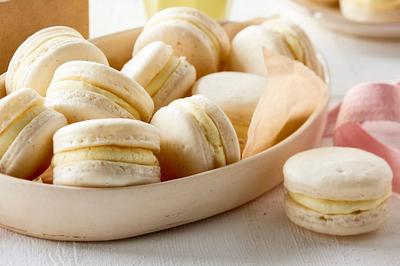VANILLA BEANS | SOYBEAN OIL | SOYMEAL & CAKE | COCOA BEANS | COFFEE BEANS
Macaron Vanilla Recipe

Macaron Vanilla
A macaron or French macaroon is a sweet meringue-based confection made with egg white, icing sugar, granulated sugar, almond meal, and food coloring.
There is some variation in whether the term macaron or macaroon is used, and the related coconut macaroon is often confused with the macaron.
In English, some bakers have adopted the French spelling of macaron for the meringue-based item to distinguish the two.
Stanford professor of linguistics Daniel Jurafsky describes how the two confections have a shared history with macaroni (Italian maccheroni).
Jurafsky notes that French words ending with "-on" that were borrowed into English in the 16th and 17th centuries are usually spelled with "-oon" (for example: balloon, cartoon, platoon).
In the UK, many bakeries continue to use the term "macaroon".
The macaron is traditionally held to have been introduced in France by the Italian chef of queen Catherine De Medici during the Renaissance.
Since the 19th century, a typical Parisian-style macaron is presented with a ganache, buttercream or jam filling sandwiched between two such cookies, akin to a sandwich cookie.
The confection is characterized by a smooth squared top, a ruffled circumference—referred to as the "crown" or "foot" (or "pied")—and a flat base.
It is mildly moist and easily melts in the mouth. Macarons can be found in a wide variety of flavors that range from traditional (raspberry, chocolate) to unusual (foie gras, matcha).
How to make Macaron Vanilla
Macaron recipe
Resepi macaron vanilla
These elegant, delicate, and delicious french macarons are the perfect treat for your next get together!
Prep Time 15 minutes
Cook Time 25 minutes
Total Time 40 minutes
Servings 36 Macarons
Ingredients
For the Cookie
100 g egg whites room temperature 3 large eggs
140 g almond flour 1 1/2 cups
90 g granulated sugar just under 1/2 cup
130 g powdered sugar 1 cup
1 tsp vanilla 5mL
1/4 tsp cream of tartar 800mg
For the Buttercream
1 cup unsalted butter softened 226g
5 egg yolks
1/2 cup granulated sugar 100g
1 tsp vanilla
3 tbsp water 30mL
1 pinch salt
Cooking Directions
For the Macarons:
Sift the confectioners sugar and almond flour into a bowl.
Add the room temperature egg whites into a very clean bowl.
Using an electric mixer, whisk egg whites. Once they begin to foam add the cream of tartar and then SLOWLY add the granulated sugar.
Add the food coloring (if desired) and mix in. Continue to beat until stiff peaks form.
Begin folding in the 1/3 of the dry ingredients.
Be careful to add the remaining dry ingredients and fold gently.
The final mixture should look like flowing lava, and be able to fall into a figure eight without breaking. Spoon into a piping bag with a medium round piping tip and you’re ready to start piping.
Pipe one inch dollops onto a baking sheet lined with parchment paper (this should be glued down with dabs of batter). Tap on counter several times to release air bubbles. Allow to sit for about 40 minutes before placing in oven.
Bake at 320F for 12-15 minutes, rotate tray after 7 minutes. Allow to cool completely before removing from baking sheet.
For the French Buttercream Filling:
Combine sugar and water in medium saucepan. Heat over low heat while stirring until sugar dissolves. Increase heat to medium- high and bring to a boil.
Put egg yolks in a stand-mixer fitted with a whisk attachment and beat until thick and foamy.
Cook the sugar and water syrup until it reaches 240 degrees F. Immediately remove from heat. With mixer running, SLOWLY drizzle hot syrup into bowl with yolks.
Continue mixing until the bottom of the bowl is cool to the touch and the yolk mixture has cooled to room temperature.
Add in butter one cube at a time allowing each piece to incorporate before adding the next. Add vanilla and salt. Continue mixing until buttercream is smooth and creamy. (About 5-6 minutes.) Add food coloring if desired.
For Assembly
Pipe your filling onto the back of half the shells. Form a sandwich and repeat. Macarons should be aged in the fridge for 1-3 days for best results. This allows the filling to soften the shells inside.
Author John Kanell
If you haven't yet found what you were looking for or you need detailed information about the subject matter on this page then... feel free to ask our business travel consultants. |




